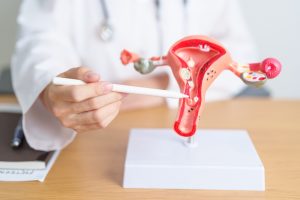Pelvic pain associated with endometriosis often becomes chronic and can persist (or recur) even after surgical and hormonal interventions. According to results published in the journal Regional Anesthesia & Pain Medicine, treating pelvic floor muscle spasms with botulinum toxin can relieve endometriosis pain and improve quality of life. The study was led by Dr. Pamela Stratton, a gynecologist and scientist at the National Institute of Neurological Disorders and Stroke (NINDS), along with Dr. Barbara Karp, a neurologist and program director at NINDS. The institute is part of the National Institutes of Health.
Botulinum Toxin for Endometriosis Pain
Endometriosis occurs when the lining of the uterus grows outside the womb and is estimated to affect up to 176 million women worldwide. It is an inflammatory condition that can lead to infertility and cause chronic pain. Common gynecological treatments include hormone therapy and surgical removal of the growths. In many cases, however, the pain returns after the procedures.
In the study, wom
All participants were found to have little or no pelvic floor muscle tension during the follow-up period. Within two months of the injection, all participants experienced a reduction in pain, with 11 out of 13 stating that their pain was minimal or non-existent. In addition, the use of painkillers was reduced in more than half of the participants. Before the toxin injections, eight participants reported moderate or severe disability, and after treatment, six of these patients noted improvement
The women experienced a decrease in muscle tightness and had pain relief that resulted in less disability and reduced use of pain medication. These results suggest that women with endometriosis suffer from pelvic floor muscle spasms and that these contribute to pain persisting after standard treatment. Importantly, the positive effects were long-lasting: Many patients reported pain relief that lasted at least six months.
Botulinum toxins, such as Botox, block the nerve signals that cause muscles to contract and have been used to treat migraines and certain movement disorders. Previous research has shown that botulinum toxin can help women with other types of chronic pelvic pain, but this treatment has not been studied in women with endometriosis, and larger clinical trials will need to confirm the current results. In addition, future research will focus on the mechanisms underlying chronic pelvic pain and a better understanding of how botulinum toxin can help treat these disorders.
Production of IGF-1 by Macrophages Plays an Important Role in the Development of Endometriosis Pain
Knowing the cause of endometriosis pain could open up new possibilities for pain relief. A team of researchers focused on the role of macrophages, a type of white blood cell found in our immune system, in contributing to the pain caused by endometriosis. Macrophages adapt their functions according to local signals and are thus altered by the disease. They are increasingly attracted to the foci of endometriosis and are also found in large numbers in the foci themselves.
In a cell culture of these pathologically altered macrophages, the scientists observed an increased production of insulin-like growth factor-1 (IGF-1). When this factor was applied to nerve cells grown in culture, they found that this stimulated the nerves to grow and also activated them, showing that the production of IGF-1 by macrophages plays an important role in the development of pain in endometriosis. To further confirm their findings, the researchers examined peritoneal fluid from women with endometriosis and found increased levels of IGF-1 compared to women without the disease. These women also reported having more pain.
Previous studies have shown that macrophages may play a role in other types of chronic pain, but this is the first time a link has been shown with endometriosis. According to lead author Dr. Erin Greaves of Warwick Medical School, it is important to learn more about the role of macrophages in endometriosis so that they can be distinguished from healthy macrophages and treatment can be targeted to them.
It is known that macrophages change their function depending on their local environment and therefore adopt a different gene expression in the presence of endometriosis lesions. This not only increases pain sensitivity at this site, but may also be a potential marker for targeted treatment. This discovery will help to find ways to alleviate the symptoms of women suffering from endometriosis. The researchers hope that in the future they will be able to learn exactly how disease-modifying macrophages in endometriosis promote the disease and how they can target them to treat endometriosis.





